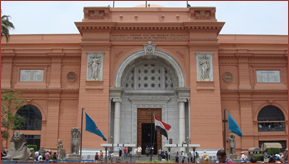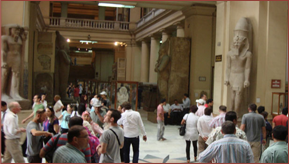The Grand Egyptian Museum holds in trust for Egypt and the World a chronological statement for the ancient history of Egypt over the past 7000 years. Neighboring a timeless wonder, the Giza Pyramids, the new museum is to pay homage to eternal Ancient Egyptian monuments, treasures, and history hosting over 100,000 artifacts, about 3500 of which belong to the famous King Tutankhamen. The design for the Grand Egyptian Museum was reached as a result of an international architectural competition initiated by the Ministry of Culture on January 7th, 2002. The competition was under the patronage of the UNESCO and supervised by the UIA. The museum complex aims to furnish all its visitors with a uniquely enjoyable, educational, and cultural experience. The Grand Egyptian Museum will allow Egypt to become a major worldwide hub for Pharonic history and a must-visit place for Egyptologists. The museum aims at taking grasp of the diversity of Egypt's heritage of monuments and arts needed to be shown in one place in one location to maintain and preserve this huge legacy. The site chosen for the GEM is only 2km from the legendary Pyramids. Nested between the ancient Great Pyramids and the modern city of Cairo, at the junction between dry desert and the fertile floodplain, the Grand Museum is a portal to the past. The Giza plateau Memphis and its Necropolis nominated by UNESCO among the world Cultural Heritage Sites, contains irreplaceable monuments from across time.The museum complex will be built on a plot of land approximately 117 feddans, about 480,000 square meters. With its unique position on the cusp between the past and the present, the Grand Egyptian Museum will lie at the repository for ancient artifacts that creates an interactive experience for the visitor; it will build a bridge between the past and the future.
Historical Background
 | | Egyptian Museum |
|  | | Egyptian Museum |
|
The present Egyptian Museum in Cairo was designed at the end of 19th century and inaugurated on November 15th, 1902.The museum adopted a neo-classic style, keeping with its immediate architectural surroundings and reflecting the classical tendencies of many of the artifacts it was intended to house. The building was designed to facilitate the easy flow of visitors from one gallery to another, while taking into account contemporary standards of air-circulation and natural lighting.When the museum was inaugurated it had approximately 500 visitors daily, circulating within 15,000 sqm. ; today the visitors’ number reaches 5,000 – 7,000 a day . Back then, the museum housed 35,000 artifacts ; today the museum houses more than 140.000 objects, excluding those currently stored in the basement of the building. Still more objects remain in the warehouses attached to various archaeological sites elsewhere in Egypt.
With around 2.500.000 visitors annually, over-crowding has become an inevitable problem. Consequently, the Egyptian government has allocated a piece of land, with the great pyramids of Giza as its backdrop, on which to build the Grand Egyptian Museum. The GEM is intended to house more than 100.000 artifacts.
On 4th of February 2002,the foundation stone of the Grand Egyptian museum was laid to announce to the world that Egypt is committed to build a significant cultural monumental and to send a global message that the Egyptian civilization will always be a source of enlightenment.
Mission and Vision | The Mission | | Egypt has been known as the most ancient center of civilization, art and culture. Throughout history, during the Pharaonic, Greco-Roman, Coptic and Islamic periods, even during times of invasion, art has operated as a common denominator. The constant expression of life through art has remained an inherent trait of Egypt and its inhabitants. The Grand Egyptian museum is conceived to be an exemplary manifestation of this trait, exhibiting civilization with all its dynamics: the land of Egypt, kingship and state, daily life, religion and knowledge. The mission of the museum is to preserve, document, conserve, research, exhibit its collections and educate and entertain its visitors, whether adults or children. The major concern of the museum is to satisfy visitors through serving as a world –class, hospitable and dynamic institute in order to engineer new experiences capable of raising the visitors’ curiosity and including the pleasure of discovery and enjoyment of culture. |
| The Vision | The unique legacy of this ancient civilization needed to be presented within a single building. This edifice is a repository and a showcase for the development and achievements of Ancient Egypt. But then the question rose "How can one building span the area between heaven and earth?" Only LIGHT can span this space between Heaven & Earth, and through light, vision is born, that which has guided the Pharaohs and all of creation. The Grand Egyptian Museum was guided by this vision, a single source; faint yet filled with the strength to glow with the power of a thousand suns. This source was the inspiration to build this edifice and bring about its birth through an exceptional concept and an outstanding design. The Grand Egyptian Museum a place that allows its visitors a unique experience of going back in time and navigating through the story of Ancient Egypt over the past 7000 years, and enjoying a voyage through one of the richest cultural heritages ever created.
Museum Location
| | | | | The Grand Egyptian Museum is located only 2 kilometers from the Giza Pyramid plateau that is included in the UNESCO World Heritage Site list, which extends in a north-south direction for about 30 km from Abu Rawash to Dahshour, including the Abu Ghorab, Abu Sir and Saqqara archaeological area. North of the Pyramids plateau is the Hassana Dome, a singular geomorphologic feature designated as a Protected Area. The area allocated for the Grand Egyptian Museum is about 480,000 sq.m. It exists on a higher hill at the beginning of the Cairo-Alexandria desert Road and is also accessed from the Fayoum Desert Road .
Museum Site With Connection to PyramidsThe Grand Egyptian Museum establishes a strong visual relationship to the Pyramids. In effect, it creates a single site for the Museum and the ancient wonder establishing a kind of formal dialogue. The top of the Museum level will have a wonderful panorama of the three Giza Pyramids without obstacles. Nested between the ancient Great Pyramids and the modern city of Cairo, at the junction between dry desert and the fertile floodplain, the Grand Egyptian Museum is a portal to the past. While the Museum is organized within the visual axis from the site to the Pyramids , the site organization also describes a relationship to Cairo. From the top of the plateau the path of the Nile Park inscribes a
cone of vision to Cairo creating the opportunity for a viewing point both over the city and the Pyramids. The site acts as the intersection between modernity and antiquity, literally redirecting the visitor from the modernity of Cairo and Alexandria to the ancient heritage of the Egyptians. Museum Master plan GEM Landscape Plan The functional areas and spatial sectors for GEM have been identified with reference to the various activities corresponding to the requirements of users and staff, and to fulfill the objectives of the project. The total area of the development (indoor – outdoor) is estimated to cover 480,000 square meters. | | | The Grand Egyptian Museum is a complex of buildings and landscape with one identity. The Master plan geometry structures the site at all scales from site plan to exhibition show cases, such that navigation within the complex is straightforward. The Landscape displays a number of thematic parks cafes and restaurants that offer entertainment and enjoyable resting places. This concept extends beyond site boundaries as the main building is structured by the sight line from the site to the pyramids. The main building comprises various exhibition spaces, library, mediatheque, education centre, conference centre and retail but is represented externally by one coherent surface-the translucent Serpinski Wall. On approach to the site from Cairo, the Serpinski Wall captures visitors’ attention and will be appreciated with reference to the pyramids. This wall is the iconographic identity for the entire complex. | | | The GEM is designed in such a manner to create a world class building capable of demonstrating the progress, evolution and development of the Egyptian Civilization. The technological infrastructure of the complex allows for the creation of modern archives and a library capable of facilitating the management, maintenance, and preservation of the collection, as well as research-related activities. |
|
|
|
|
|
|
|
|